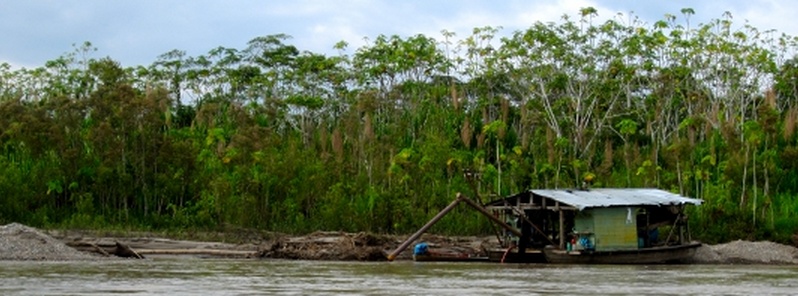Mercury from gold mines accumulates hundreds of miles downstream

Duke University researchers have found hazardous levels of mercury hundreds of miles downstream from Peruvian gold mines.
Researchers have determined that the health risks taken on by artisanal, small-scale gold miners extend far beyond the miners themselves.
Based on a study of gold-mining operations in Peru, the miners’ practices not only contaminate local soil, sediment and water resources with mercury, they create hazardous levels of the neurotoxin in the food chain at least 350 miles downstream.
The study, led by Heileen Hsu-Kim, professor of civil and environmental engineering at Duke University, William Pan, professor of environmental science and policy and the Duke Global Health Institute, and Sarah Diringer, a Ph.D. candidate mentored by the pair, was recently published online in the journal Environmental Science: Processes & Impacts.
The Duke team looked at the wide-reaching effects of mercury contamination from gold-mining operations in Peru’s southern Amazon region of Madre de Dios. However, the same mining practices are present throughout South America, as well as in Africa and Asia.
As the price of gold has soared during the past decade, thousands of Peruvians—mostly from the Amazon and sierra region of Cusco—have embraced artisanal small-scale gold mining to supplement their income. Mercury is used to bind loose flakes and bits of gold ore into hard chunks that can be more easily extracted from soil and sediment, and then burned off with blowtorches once the chunks are in hand.
The study found that the miners and their families are highly vulnerable to the impacts of mercury, with limited knowledge of mining’s environmental or human health effects. Rarely do they have adequate safeguards to limit the release of mercury into the air, soil or water, the researchers said.
Once in river sediments, mercury is taken up by microorganisms that convert it to a highly neurotoxic form. As other animals consume the microorganisms, the levels of the neurotoxin accumulate in larger predators, such as carnivorous fish, according to the study.
A small-scale gold mining operation docks along the Madre de Dios River in Peru. Small boats remove sediment from nearby riverbank where mercury is added to extract gold. Recently, the Peruvian Navy has begun to crackdown on mining operations directly on the river by bombing small boats such as this one. Image credit: Sarah Diringer/Duke
“We’ve known that the use of mercury presents health risks to miners and their families, but it also releases a lot of contamination that ends up downstream,” said Hsu-Kim. “Some of that mercury ends up in fish that other communities depend on as part of their diets, and that risk was not documented at all. We had heard anecdotal evidence, but this was the first scientific study to document the actual contamination.”
In the study, Hsu-Kim, Pan and their colleagues took samples from river sediment, water and fish at 62 sites near 17 communities over a 350-mile stretch of the Madre de Dios River and its major tributaries. The results showed an increase in mercury concentrations in the mining areas as well as downstream, where concentrations in fish now exceed World Health Organization guidelines for safe consumption for children and women of maternal age.
“The calculations were made assuming that people ate two fish meals per week,” Hsu-Kim said. “However, we have preliminary data from household health surveys indicating that fish consumption is actually much higher in many communities, which could increase the body burden and exceed safety limits even for healthy adults.”
While mercury can be dangerous to adults, the primary concern is how it can impair neurological development in children, infants and fetuses. Because mercury can cross the placental barrier if it is ingested by the mother, the metal can affect the development of a baby's cardiovascular and nervous systems.
Source: Duke University
Reference:
- "River Transport of Mercury from Artisanal and Small-Scale Gold Mining and Risks for Dietary Mercury Exposure in Madre de Dios, Peru," Diringer, S. Feingold, B. Ortiz, EJ. Gallis, JA. Araujo-Flores, JM. Berky, A. Pan, WK. Hsu-Kim, H. Environmental Science: Processes & Impacts, Dec. 19, 2014. – DOI: 10.1039/C4EM00567H
Featured image credit: Sarah Diringer/Duke

And theat mercury is chemically inert and IMpregnatied with Gold Platinum Siver or other precious metals. The Mercury from cinnaBar does NOT Gassify/ Off Gas until over 100° F. It IS the Liquid Metal that is used in Themometers Boudon Tubes and Mercury Gravity Switches? Getting the Gold OUT is the “tricky” part as Aqua Regia (Royal Water) consists of Sulpuhuric Nitric Chlorine and other caustic chemicals which can be Very Dangerous to inhale or Breathe. and The Off Gassing from Cooking off Gives of “RED DEATH.” Use all due caution.